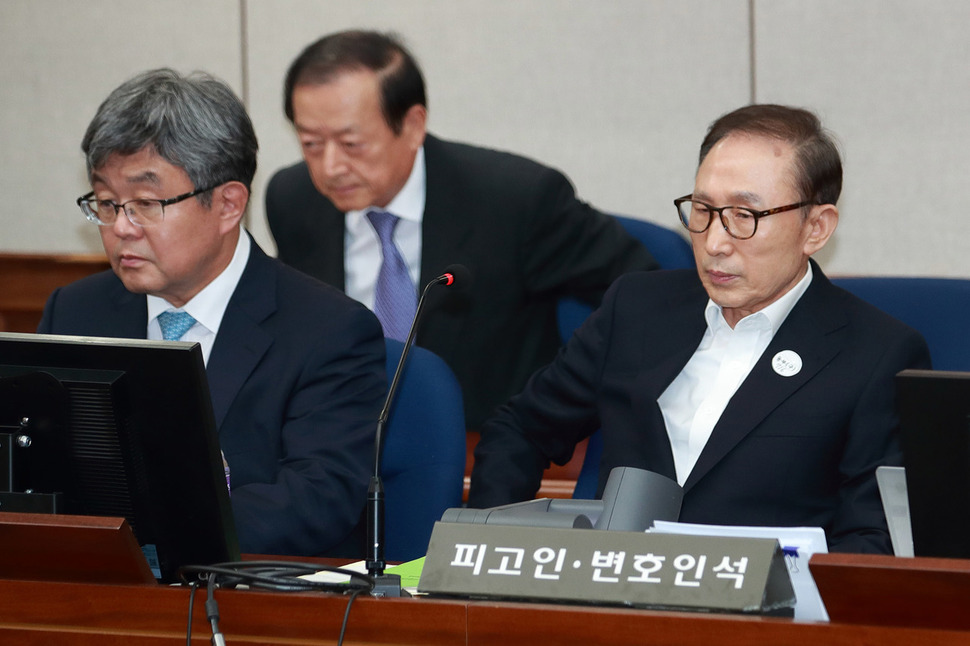 |
|
Ex-president Lee Myung-bak at his first trial on May 23.
|
NIS also kept tabs on judges deemed “leftists”
It turns out that the South Korean police tracked the movements of former president Roh Moo-hyun and reported them to the Blue House during the presidency of Lee Myung-bak. Documents disclosed in an ongoing trial also contain evidence that the National Intelligence Service (NIS) labeled people critical of how the Lee administration was running the country as “leftists,” going so far as to call for a “leftist judge” to be discriminated against in personnel decisions. During a hearing in Lee’s trial held on Aug. 21, Hon. Jeong Gye-seon, a judge with the 27th Criminal Division of the Seoul Central District Court, conducted an evidentiary review of presidential records that were seized from the Yeongpo Building in Seoul’s Seocho District. The Yeongpo Building – the property of the Cheonggye Foundation, which was established by Lee – was where the prosecutors found more than 3,400 presidential records in the course of a raid this past January. Lee is being tried for the unauthorized destruction, distribution and search and seizure of presidential records, which would constitute a violation of the Act on the Management of Presidential Archives. The documents released by the prosecutors apparently show the police briefing the Blue House on the results of their secret investigation into Roh during Lee’s administration. The prosecutors explained that a document from the National Police Agency called “Public Opinion Regarding a Political Website Established by Former President Roh Moo-hyun” provided “ongoing reports about Roh’s current status and actions, including the times he went golfing.” “The police were also constantly verifying rumors about Roh’s older brother Roh Gun-pyeong, who was in Bongha Village,” the prosecutors said. Discussion of disciplinary measures against “left-leaning judges” Multiple documents were also disclosed in which the NIS considered taking disciplinary measures, including unfavorable personnel assignments, against judges that it identified as “left-leaning” because of their forward-looking judgments in controversial cases. In a document called “Leftist Bias in the Courts and Potential Countermeasures,” the NIS mentioned “examples of left-leaning judgments,” including one involving a strike by the Korea Cargo Transport Workers Union. “The Korean Legal Research Association, a group of judges with progressive leanings, is advocating a leftist position in controversial cases,” the NIS asserted, saying that “pressure should be applied in a variety of ways, such as by shaping public opinion.” A document called “Preemptive Action on Recent Indications of Reverses in the Drive to Reform the Leftist Bias in the Courts” called for “the director of the National Court Administration to express concerns about leftist forces through direct and indirect channels, arrange a counterattack by the conservative press and continue reviewing ways of sanctioning leftist judges by assigning them to trivial posts and forcing them out of the profession altogether.” Furthermore, a document called “The Reality of Leftist Bias in the Judiciary and Potential Countermeasures” calls for “pressuring the courts to give undesirable personnel assignments to left-leaning judges, such as those active in the Korean Legal Research Association, weeding out the leftists from potential jurists and closely monitoring the ideological tendencies of law school students to prevent leftists from joining the prosecutors and the courts.” Plan for controlling media organizations The Lee administration also considered cracking down on critical media organizations and journalists, which it labeled as the “leftist media.” A document called “Creating a Culture of Fair Broadcasting by Preventing the Resurgence of Left-Leaning Media Personalities” contains the following passage: “Some problematic programs have been purged, but others are still causing problems. There needs to be house-cleaning of broadcasters’ management to strengthen the foundation of fair broadcasting, and a personnel reshuffle during the programming update in the spring will be used to eradicate key figures.” A document called “Eliminating Biased Broadcasting Through the Strict Prosecution of Leftist Media Personalities” talked about bolstering cooperation between the leaders of the prosecutors and the police in regard to taking legal action against left-leaning media figures, and there was also a document that mulled a “reorganization” of MBC and the Korea Communications Standards Commission (KCSC). A document called “MINBYUN’s Bolstering of Support for the Left and Countermeasures” promised to “respond to group lawsuits by leftist lawyers by mobilizing the National Tax Service and the Defense Ministry to review their lawsuits and turn up examples of inappropriate income and unofficial contracts,” while another called “The Necessity of a Personnel Shuffle at the NHRC” called for “highlighting bias at the National Assembly and strengthening the vetting system.” These documents indicate that the government was attempting to tame groups like MINBYUN-Lawyers for a Democratic Society and agencies such as the National Human Rights Commission of Korea (NHRC) by restricting their activities. The prosecutors believe that Lee was briefed on the documents composed by the NIS and other agencies. By Kim Min-kyoung, staff reporter Please direct comments or questions to [english@hani.co.kr]






